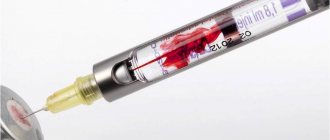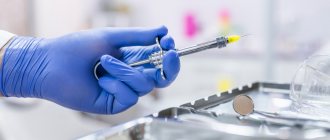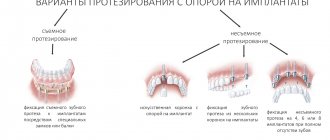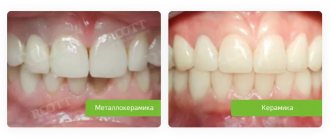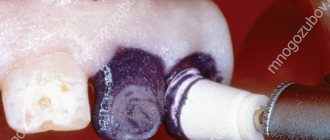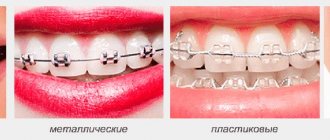Composite materials have been used in dentistry for eliminating aesthetic defects and restoring teeth damaged by caries for 40 years. During this period, adhesives have been improved more than once, and their use has become easier. To improve adhesion as a result of dentin hybridization, an alcohol protocol is used.
What is an alcohol protocol?
A protocol in medicine is recommendations for treatment developed by scientific and medical communities. These recommendations are scientifically based, within the framework of evidence-based medicine, practice-oriented guidelines for action.
The alcohol protocol is a recommendation for the use of an alcohol solution, which is necessary for dentin hybridization. Alcohol is used to inhibit metalloproteinase enzymes, which are formed in dentin under the influence of phosphoric acid.
Opinion of Alexey Olegovich Sazonov
In the video, Sazonov’s technique:
Alexey Olegovich Sazonov graduated from MGMSU - Moscow State Medical and Dental University named after. A.I. Evdokimov, majoring in Dentistry. Doctor - dentist-therapist, orthopedist, chief physician of the Art-pro clinic. Work experience - 19 years.
He does not use Chlorhexidine, because he considers its action useless: “MMPs are needed for the transition of altered dentin to sclerotic types.” This is necessary in the presence of deep caries, to strengthen the affected but healthy tissues. Chlorhexidine, according to the doctor, can prevent this. Sazonov uses 95% alcohol. For different generations of adhesives, the operating algorithms are different. More often, Alexey Olegovich adheres to the following sequence (4th generation: acid, primer, adhesive):
- Selective dynamic etching of enamel 15 sec with phosphoric acid, dentin 3-5 sec.
- Rinse with water, DO NOT dry, add 95% alcohol (water from a syringe for 30 seconds), do not dry.
- Rub in the primer 3 times, dry well (1 time).
- Rub in the adhesive and inflate.
- Apply the fluid-flowing composite in a thin layer.
- Polymerization - 10 sec.
There are many articles and studies on this topic, they often contradict each other. First of all, you need to understand the causes of the problems, and not blindly accept recommendations on faith. The relevance of the alcohol adhesive protocol in dentistry will only be confirmed by the long-term durability of restorations.
What are adhesives used for in dental treatment?
An adhesive is an intermediate substance to provide a bond between surfaces. An example is the connection of etched tooth enamel and a composite material, between which an enamel bonding adhesive is placed.
For what purposes do doctors use adhesives? They are necessary for installing composites when restoring anterior teeth that have been damaged mechanically or by caries, and when correcting visual defects of dental units.
Stages of the procedure
Procedure:
- First, the enamel is etched with phosphoric acid for 5 s, then the dentin is etched for 5 s. After which the acid is washed off with a water jet without further drying.
- The cavity is washed with 95% alcohol for 30 s. It is applied using a syringe, spreading it over the cavity with a brush or using a moistened cotton ball, rubbing it into the surface. For 4th generation adhesives, alcohol is required; if preparations of 5th generation and higher are used, then a solution containing 95% alcohol and 2% chlorhexidine is used.
- After the alcohol is applied, the surface is not dried, but the adhesive is immediately rubbed in. It is rubbed in 3 times and then dried. At the end, a fluid-flowing composite is used and the surface is polymerized.
In search of perfect adhesion
Since the advent of the 4th generation bonds, for many years nothing significant has happened in adhesion to dentin; the new bondings turned out to be less effective than the previous ones. In 2006, the Surpass adhesive appeared, showing absolute innovation both in the strength and durability of the bond and in its operating mechanisms. Suffice it to say that the shear strength of the ligament is 50 mPa after 5 years for enamel and dentin.
The history of adhesive dentistry began in 1955 with the publication of an article by Michel Buonocore on the possibility of improving adhesion by etching enamel with 85% phosphoric acid, similar to the preparation of metal for painting in the automotive industry. Since then, many adhesives have been released, quite long-term bonding with enamel has been achieved, but the durability of dentine bonding still remains a significant problem, most new adhesives turn out to be even worse than the old ones, manufacturers strive to simplify and reduce it to a single jar...
The enemies of adhesion to dentin are the following factors:
- hydrolytic degradation of the hybrid layer;
- activation of relic proteinases both during etching and when adding adhesive;
- difficulty in passing monomers through a layer of demineralized collagen fibers;
- osmotic activity of the hybrid layer in self-etching bonds;
- difficulties in achieving optimal moisture content of the dentin surface when using total etch adhesives.
Significant difficulties have arisen with self-etching adhesives (6th and 7th generations): they all do not etch the enamel enough and either do not etch enough or even after polymerization continue to etch the dentin, leaving gaping holes around the tags. All etching products remain in the hybrid layer, causing osmotic activity and rapid hydrolytic degeneration. Acidic monomers activate matrix metalloproteinases and cysteine cathepsins, which also leads to rapid degradation of collagen fibers in the hybrid layer zone. Most self-etch adhesives remain hydrophilic and acidic after polymerization, and the presence of acidic monomers in the oxygen-inhibited layer causes problems with the use of cements and dual-cure core materials, and also interferes with the polymerization process of light composites. This problem is not completely resolved in dual-cure self-etch adhesives. The release and widespread advertising campaign of selective etching adhesives looks like an act of desperation by manufacturing companies.
Two-component total etch adhesives (5th generation) were a simplification and combination of components of the 4th generation; they, like self-etch adhesives, often have a significantly acidic pH reaction, often the pH is only slightly above 2, which has the same consequences for dentin as and self-etch adhesives, with exactly the same difficulties.
There are other difficulties with the 5th generation: the fact is that after etching and washing the dentin, there is not water at all between the collagen fibers - there is a highly hydrated proteoglycan gel, the distances between the fibers are very small, and only monomers with low molecular weight can penetrate through this barrier is called “molecular sieves”. None of the officially existing bonding protocols are aimed at destroying the hydrogel. In one 5th generation jar, low molecular weight monomers form comonomers with large molecular weight monomers. Will these comonomers be able to overcome the molecular sieve barrier? The 5th generation adhesive layer is partially hydrophilic and acts as a semi-permeable membrane, creating problems with debonding and post-operative sensitivity under standard protocols. In vivo, a regular bond with a standard protocol degrades on dentin in just 1 year; the use of a protocol with BAC and CHX can only delay the collapse of adhesion to dentin.
Three-component total etch adhesive systems (4th generation) are today the “gold standard” of adhesion, showing the highest results in both bond strength and adhesion duration. However, not all is well here with adhesion to dentin. When etching, proteases are activated, the use of protocols with BAC and CHX can delay the onset of degradation by no more than 1.5 years, low molecular weight monomers penetrate dentin better, but most of them contain acidic monomers or organic acid and can continue to activate enzymes in dentin, There are no formal protocols aimed at disrupting the proteoglycan hydrogel and expanding the interfibrillar spaces. 4th generation bonds are extremely sensitive to surface moisture; with excessive moisture or dryness, the bond strength indicators decrease by 3 times and can give completely unacceptable figures, below the polymerization stress, leading to debonding and postoperative sensitivity. This is why researchers are so keen on wet self-etch bonding.
This sad situation, supplemented by the deliberate introduction of dentists into the opinion that almost all adhesives are equally good, produced by all well-known manufacturing companies: just, they say, follow the protocol - hushing up problems with adhesion to dentin, a lot of paid articles on adhesion and a lack of interest Most dentists in the post-Soviet space (and throughout the world) have led to a significant simplification of protocols and the widespread use of self-etching and two-component total etching systems. The advertising flywheel is only gaining momentum...
Against this sad background, there are works of researchers based on the destruction of the proteoglycan hydrogel and improving the stability of the hybrid layer. In particular, I would like to highlight the work of Dr. John Kanka, well known for his discovery of wet bonding while working at Bisco, who also created all-bonds. After leaving Bisco, John focused on completely different adhesion principles - for the first time in 50 years! The history of adhesion took into account not only chemical, but also physicochemical processes occurring on the tooth surface during the adhesive protocol. The first in the line was the two-component adhesive Simplisity, which is still loved by many doctors for its ease of use and unique durability of the ligament. In 2006, a new three-component adhesive Surpass was introduced in the USA, which showed absolutely unique indicators both in terms of ligament strength and duration of adhesion to dentin; after 5 years, the shear strength of the ligament for enamel and dentin is around 50 mPa, unprecedented and unsurpassed indicators still…
Sales of Surpass were not accompanied by noisy performances; rather, the information was disseminated among perfectionist dentists and came to us through our American colleagues. The work on creating “Surpass” lasted 4 years; the bonding processes are completely unique, have no analogues in the industry, and are protected by several patents in the name of John Kanka.
The operating principles of “Surpass” are so new that Apexdental wrote on the packaging with the bond: “Self Etch adhesive,” although John himself positions his product as a 4th generation bond with indelible acid, or 8th generation of adhesives. Understanding the basics of physical chemistry and the modern work of researchers in the field of relict proteases will help you understand the basics of how bonding works.
The process of etching enamel and dentin creates an extremely complex environment called a dispersed system. By the way, it is also presented in composites; there are also many particles in a colloidal medium...
If we consider the process of etching the tooth surface with acid, not only micromechanical retentions occur, but also a charged surface. Acid molecules and etching derivatives can either be washed away with water or replaced by other molecules, and they will occupy exactly the places where the acid molecules were.
If we consider this process in relation to “Surpass”, then the biggest secret is contained in the Sur1 bottle; it contains an inorganic acid, an organic acid and an ethylenically unsaturated monomer with a -coon group, as well as a surfactant.
The only comparison of the process can be the production of Langmurr-Blodgett film in the production of crystals in microelectronics. An even more complex phenomenon occurs on the surface of the tooth, which is in the nature of continuous stepwise adsorption: inorganic acid is capable of etching enamel in the same way as 37% phosphoric acid. When it is used up, the organic acid begins to act, displacing the etching derivatives and forming a double charged layer on the surface of the dentin.
The third substance is a dispersant and cross-linking agent, introduced at the etching stage. When a primer (Syur2), an anhydrous alcohol solution of the monomer, is added, organic acid molecules are replaced by HEMA molecules, which is described by Rehbinder’s polarity equalization rule. Acid residues are emulsified and neutralized by excess tertiary amines in the primer.
Thus, the monomer is packed incredibly tightly and the issue of hydrolytic degradation of the polymer is resolved. There is no need for benzalkonium chloride or chlorhexedine, since they are not capable of providing adhesion; moreover, these substances, by their nature, can only exist in aqueous solutions and would not be able to exist in an anhydrous environment anyway. Conversely, due to the imperfections of many adhesives, these substances will be present in areas where water remains when using a BAC or CHX protocol or incorporating CHX into self-etching bonds. Research by colleagues in the field of oncology sheds light on the inhibition of MMPs: -coon groups are able to non-covalently attach to the chemopexin-like domain of the metalloproteinase zymogen. The works of Brazilian colleagues in the field of dentistry (published in 2013) and other famous scientists (David H. Pasley, Fraklin R. Tay, etc.) also confirm this hypothesis. In the works of David Pashley, the idea of the possibility of attaching a monomer directly to collagen fibers is repeatedly encountered, which may well be the case. The anhydrous alcohol composition of Surpass2 is also important.
Surpass3 is a hydrophobic resin that can be blown to a thickness of 10 microns, which is important for indirect restorations. “Surpass” is a completely neutral bond (this is what distinguished all-bonds from “Bisco”), therefore it is compatible with all composite materials and cements, including double-curing.
We are now able to use an adhesion product that is unmatched in both bond strength and adhesion stability. "Surpass" redefines the "gold standard of adhesion".
To achieve the specified characteristics, it is necessary to follow the protocol and be sure to use a compressor with an air dryer (water and humidity are the enemy of any adhesives).
It is highly advisable to install a separate air-only gun equipped with a pressure regulator (the same as for any adhesive).
The article is of a review nature; many details can be found in the literature or in the distributor’s protocols: for example, how to dry the adhesive correctly and why exactly, why such high adhesion strength is needed, etc. There is also a John Kanka forum on the manufacturer’s website.
The list of references is in the editorial office.

